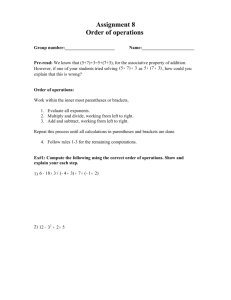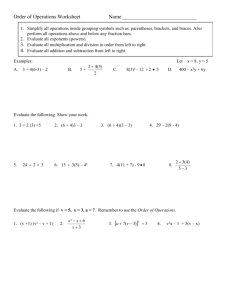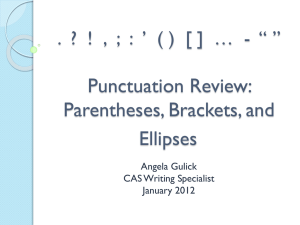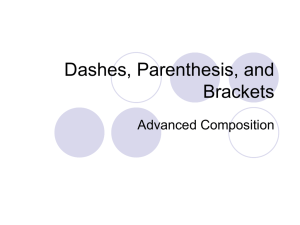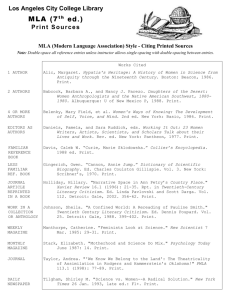Parentheses, Brackets, And Ellipses
advertisement
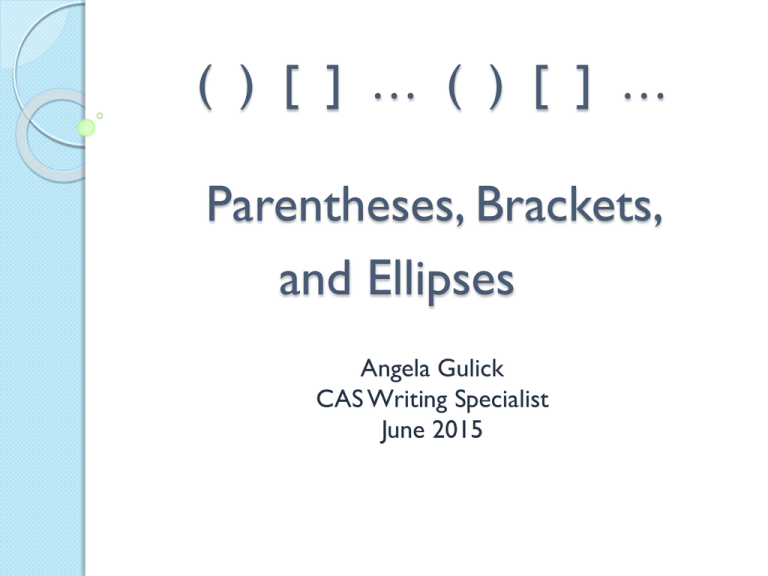
( ) [ ] … ( ) [ ] … Parentheses, Brackets, and Ellipses Angela Gulick CAS Writing Specialist June 2015 Parentheses ( ) ( ) ( ) ( ) ( ) ( ) ( ) Use parentheses to enclose information that is interesting but not crucial. In other words, information in parentheses could be removed and you would still have a complete grammatical sentence. Parentheses should be used sparingly in college writing because they tend to produce a choppy effect. Aunt Matilda (bless her heart) is 113 years old. The last time I was I Las Vegas (in 2006), I was amazed by the Hoover Dam. I love to create my own meals (and by create, I mean I love opening bags of chips and salsa). Often, information that is separated by two commas could just as easily be put into parentheses. Aunt Matilda, bless her heart, is 113 years old. The last time I was I Las Vegas, in 2006, I was amazed by the Hoover Dam. I love to create my own meals, and by create, I mean I love opening bags of chips and salsa. Parentheses ( ) ( ) ( ) ( ) ( ) ( ) ( ) Another way to use parentheses is to use them as part of a system of documentation, such as Modern Language Association (MLA) or American Psychological Association (APA) documentation. Parentheses are often used to enclose authors’ names, page numbers, and dates. MLA system: According to one author, “road rage” has been replaced by “plane rage” in which frustrated and angry passengers of planes behave with aggression and sometimes even violence (Hansen 32). >>>The MLA system uses the (author(s) page number) approach. APA system: Two researchers have found a clear connection between the number of pieces of candy eaten at Halloween and the number of bellyaches experienced the day after Halloween (Gremmels and Graham, 2011). >>>The APA system uses the (author(s) year of publication) approach. Page numbers are only used for direct quotations. Had the information above been quoted, this is what you would see at the end (Gremmels and Graham, 2011, p. 134). Brackets [ ][ ][ ][ ][ ][ ][ ][ ][ ][ ][ ] Brackets and parentheses look similar, but they serve very different purposes, particularly when you are directly quoting information. Brackets can be used for two main reasons: to add information to a direct quotation and to alter a direct quotation for clarity. Brackets [ ][ ][ ][ ][ ][ ][ ][ ][ ][ ][ ] Adding Information to a Direct Quotation for Clarity Use [brackets] to add information to a quote to improve clarity of a concept: Katherine Hostager states, “After taking his class for just a few weeks, he couldn’t believe that he had made such progress.” >>>>> We don’t know who “he” and “his” refer to, so bracketed details clarify matters: Katherine Hostager states, “After taking [Dr. Martone’s] class for just a few weeks, [Jon] couldn’t believe that he had made such progress.” Hint: If you have to use multiple brackets [ ] in a single quotation, it is probably better to paraphrase the information (write it in your own words). Too many brackets create a text that is choppy and difficult to read. Brackets [ ][ ][ ][ ][ ][ ][ ][ ][ ][ ][ ] Altering Information for Grammatical Reasons Use [brackets] to indicate anything you have altered to make a direct quotation match your own sentence such as capitalization, subject-verb agreement, and verb tense: Original quotation: According to Jarrod Littleton, “Those who offer economic advice state that investing in retirement funds such as Roth IRAs should be the top priority for young adults.” Use of quotation: According to Jarrod Littleton, “[I]nvesting in retirement funds such as Roth IRAs should be the top priority for young adults” according to many financial consultants. >>>>>In the original, the word “investing” came in the middle of the sentence, so it wasn’t capitalized. However, now the word “investing” has been used to start the sentence and thus needs a capital “I” like any other word that would normally begin a sentence. >>>>>Only the “I” is in [brackets] because only the letter “I” was changed. If the entire word was in [ brackets], it would look like the author changed the entire word. … … Ellipses … … … … … … Three periods in a row are called ellipses. Ellipses are used with direct quotations to indicate anything you have removed from a direct quotation. Note:You cannot remove something that substantially changes the quote’s meaning. Further, you do not need to use ellipses at the beginning of a direct quotation. Original quotation: Marshall writes, “After running to the store, checking her answering machine, and feeding the goldfish, Lily collapsed into a chair and wolfed down a pint of butter pecan ice cream.” Omissions in the middle of a sentence Marshall writes, “After running to the store … and feeding the goldfish, Lily collapsed into a chair and wolfed down … ice cream.” Omission at the end of a sentence Marshall writes, “After running to the store, checking her answering machine, and feeding the Lily collapsed into a chair….” Note: In this instance, you actually see 4 dots. Three dots are ellipses and the 4th dot is a period normally end a sentence. goldfish, of the that which would Ellipses and MLA Documentation … … … … … … … … Note: The MLA Handbook recommends using [square brackets] on either side of ellipses to distinguish between ellipses you've added and ellipses that were in the original text: Marshall writes, “After running to the store […] and feeding the goldfish, Lily collapsed into a chair and wolfed down […] ice cream.” Hint: If you have to use multiple sets of ellipses in a single quotation, it is probably better to paraphrase the information (write it in your own words). Too many ellipses create a text that is choppy and difficult to read. A Quick Note about [sic] … … … … … … … … Some of you may have read a document that contained a direct quote but that also contained this: [sic]. The symbol [sic] is included in a direct quotation to show that the person borrowing that information is aware of some sort of error but is reporting the information exactly as it was found. Let’s look at an example: According to Austin Branson, “To [sic] many people find it difficult too [sic] make ends meet in todays [sic] harsh economy.” In this example, there are actually 3 separate errors enclosed in the quotation: 1. “To” should actually be spelled “Too.” 2. “too” should actually be spelled “to.” 3. “todays” should actually be “today’s.” Just as with parentheses, brackets, and ellipses, if you have a direct quotation that has multiple errors such as this example, it is better to paraphrase the information to avoid a choppy and distracting text. Do You Still Have Questions? If you still have questions, please stop by the Writing Lab (D120) or check out our list of writing workshops on the CAS Resources page. Here are additional websites that can help you with grammar, punctuation, and mechanics issues. The first two links with ’s also have online exercises with answer keys to help you practice. Grammar Bytes Note: This site might require you to download a small program onto your computer the first time you use it. Guide to Grammar and Writing Purdue Online Writing Lab (OWL) Grammar Girl The Blue Book of Grammar
